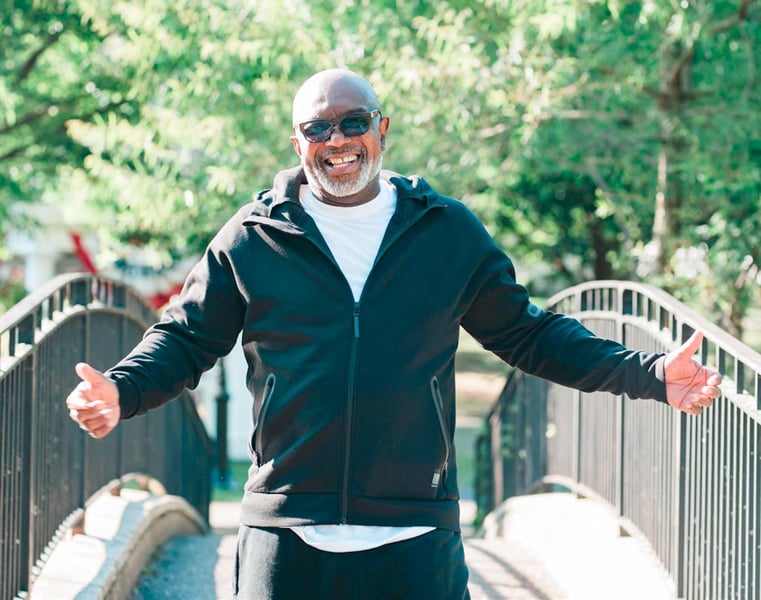Get Healthy!

- Denise Mann
- Posted February 6, 2023
His Debilitating Back Pain Lasted Decades, Until a New Implant Changed Everything
After living with disabling low back pain for nearly 30 years, Dennis Bassett, 64, finally has a new lease on life.
The Hempstead, N.Y., native injured his back in the 1980s when helping a friend. He tried everything to relieve his back pain, from self-medication, acupuncture, and chiropractor work to steroid injections, physical therapy and exercise.
"My back only got worse,"recalled the retired real estate professional. "Some days, I could barely make it into the house and up my stairs."
But that was then.
Everything changed a few months ago after his doctor suggested a new procedure that involves implanting a muscle-stimulating device called the ReActiv8 into his lower back to activate a dormant and withering core muscle. The U.S. Food and Drug Administration gave its nod to the device in June 2020.
The father of six underwent the procedure at Lenox Health Greenwich Village in New York City several months ago. Now, he is considering moving down South and starting a trucking business.
"I feel good enough that I can take a chance,"he said. "I can walk upstairs, sit down and stand up with no problem. I thought, 'this is too good to be true.'"
But when this procedure is paired with the right patient, it's not too good to be true, said Bassett's surgeon, Dr. Kiran Vishal Patel, director of pain medicine at Lenox Hill Hospital in New York City.
"This is an unprecedented procedure because it is restorative, disease-modifying, can prevent further degeneration, and allows people to be so much more active than they were,"she said.
It's not for everyone with low back pain, Patel said. "This procedure is for patients who have persistent lower back pain for more than six months and have failed to respond to physical therapy, anti-inflammatory medication and all of the typical conservative things we do,"she explained. They also don't show signs of structural damage on MRI scans.
People like Bassett have a weak multifidus muscle in their lower back. This muscle is critical for walking, sitting and bending.
"If we can activate the multifidus muscle with ReActiv8, we can break the pain cycle and allow the patient to regain core stability so that they don't develop further injury to discs, nerves or facet joints in their back,"Patel said.
During the outpatient procedure, a surgeon implants the ReActiv8 pulse generator, which is about the size of a small dental floss, into the patient's lower back and then places an electrode on each side of the multifidus muscle. The generator delivers electrical pulses to the nerves, to fire up the multifidus muscle.
Patients use a wireless remote control twice a day for 30 minutes to contract and relax their muscle, strengthening it. There is little downtime after the procedure. Most people feel slightly sore for a few days.
There is a potential downside: cost. The surgery can be expensive. Patel is working on getting more private insurance carriers to foot the bill. Insurance companies that cover neurostimulation typically pay somewhere between $20,000 to $32,000 for the procedure. If insurance isn't an option, Mainstay Medical will work with the patient, surgeon or hospital on a sliding scale to cover the costs, according to a company spokesperson.
There haven't been a lot of great treatments for low back pain caused by a weak multifidus muscle, said Dr. Dawood Sayed, division chief of pain medicine at the University of Kansas Health System in Tulsa. He took part in clinical trials that led to the approval of this device and has performed upwards of 60 procedures in and outside of the trial.
"This fills a gap in our treatment algorithm,"Sayed said.
The device is for patients with chronic lower back pain who aren't candidates for traditional spine surgery and have more pain in their lower back than in their legs, he noted.
"In a certain subset of patients, physical therapy, exercise, yoga, chiropractic care, medications and even injections can't get that muscle to fire correctly,"Sayed said. "The device hijacks the process with small electric wires to stimulate the nerve that essentially controls the main muscle."
How can you tell who will benefit from this procedure? The deciding factor is the state of the multifidus muscle in the lower back. "The MRI is helpful as we will see if the muscle has become thinner or atrophied as it looks more like muscles is replaced by fat,"he said.
Pain relief after the procedure occurs gradually and lasts at least up to three years, based on studies. "Patients are doing well at one year, even better at two years, and the three-year data show sustained improvements,"Sayed said. In a company study, 83% of patients experienced "substantial and clinically meaningful improvements"in pain or disability, or both, at three years.
"This is the first neurostimulator implant that is more of a restorative therapy to get people back to where they were and get the muscle firing,"he added.
And some people can have the device removed after the pain is gone.
Sayed is confident that more commercial insurers will begin to cover the cost of the procedure. "It is cost-effective as it means people are not going to the emergency room, taking pain medications, or missing work from back pain,"he said.
More information
The American Academy of Orthopaedic Surgeons has more on treating low back pain.
SOURCES: Dennis Bassett, Hempstead, N.Y.; Kiran Vishal Patel, MD, director, pain medicine, Lenox Hill Hospital, New York City; Dawood Sayed, MD, division chief, pain medicine, University of Kansas Health System, Tulsa





